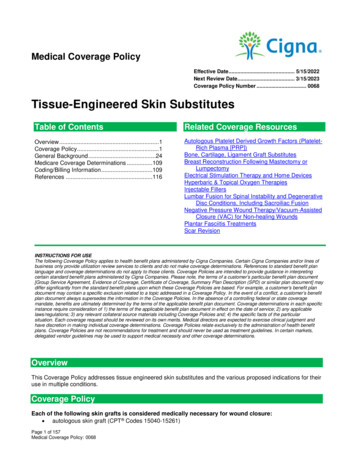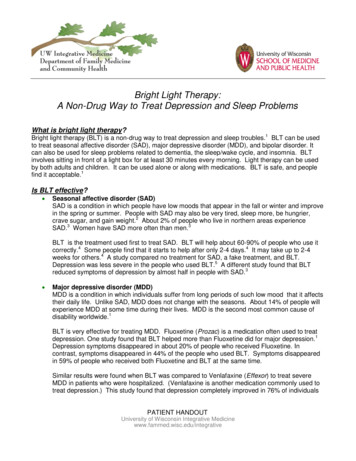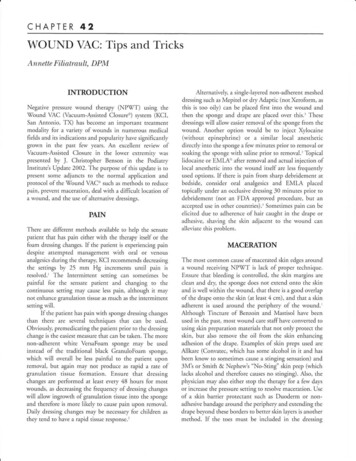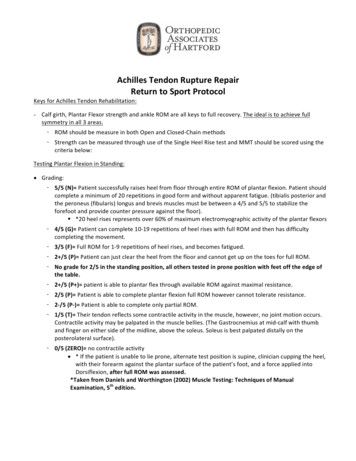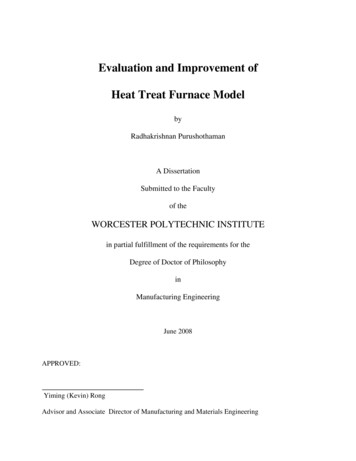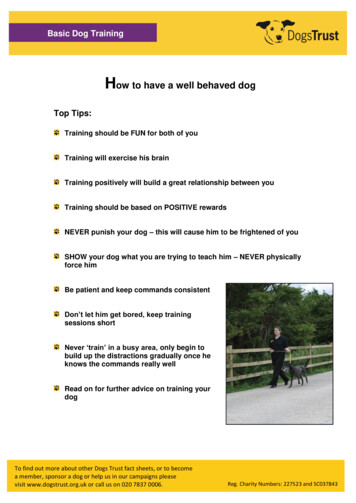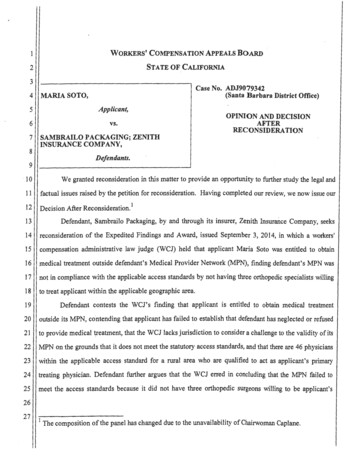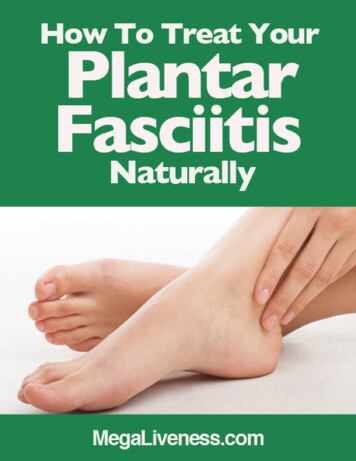
Transcription
With Contributions by:Dr. Philip Maffetone - www.philmaffetone.comDr. Ray McClanahan - www.nwfootankle.comDr Emily Splichal - www.dremilysplichal.comDr. Mark Cucuzzella - www.tworiverstreads.comDr. Steve Gangemi - www.sock-doc.com
Disclaimer:This book is not intended as a substitute for the medical advice of physicians. The readershould regularly consult a physician in matters relating to his/her health and particularly withrespect to any symptoms that may require diagnosis or medical attention.
Table of ContentsINTRODUCTION (BY DR. PHILIP MAFFETONE) . 1WHAT IS PLANTAR FASCIITIS? (BY DR. MARK CUCUZZELLA) . 2COMMON CAUSES AND SYMPTOMS OF PLANTAR FASCIOSIS?(BY DR. RAY MCCLANAHAN) .4I WOKE UP WITH PLANTAR FASCIITIS. OR DID I? (BY STEVEN SASHEN) .5THE MIRACLE THAT IS YOUR FOOT (BY DR EMILY SPLICHAL) . 6WHAT CAN YOU DO ABOUT YOUR PLANTAR FASCIITIS? (BY DR. PHILIP MAFFETONE) .8CAN YOU CORRECT PLANTAR FASCIITIS? (BY DR. MARK CUCUZZELLA).9FOOT INTRINSICS (BY DR EMILY SPLICHAL) .10WHAT ABOUT ORTHOTICS? (BY DR. MARK CUCUZZELLA). 16PLANTAR FASCIITIS: HEALING UP YOUR HEEL PAIN (BY DR. STEVE GANGEMI) .17CAN YOU CURE PLANTAR FASCIITIS WITH BAREFOOT RUNNING?. 21WHEN TO SEE A PODIATRIST OR OTHER MEDICAL PROFESSIONAL(BY DR EMILY SPLICHAL). 22GETTING “PROPER FOOTWEAR” .23WEAR ANY SHOE YOU LIKE WITH NABOSO INSOLES! . 26ADDITIONAL RESOURCES .27
Introduction (by Dr. Philip Maffetone)Plantar fasciitis is a relatively common condition in runners, walkers, and many others whospend considerable time on their feet.Characterized by pain at the bottom of the foot in front of the heel, plantar fasciitis (PF) istypically worse with the first steps in the morning or after a long period off the feet,prolonged standing, or following hard exercise. The pain is typically reduced with movementor warming up.In the U.S., visits to health practitioners for this problem cost upwards of half a billion dollarsannually. Many sufferers rely only on self-remedies or the problem spontaneously resolves,never visiting a practitioner.Unlike a fracture observed on X-ray, a definitivediagnosis of PF, like other soft tissue injury, is oftenelusive. It’s sometimes called plantar heel painsyndrome, perhaps a better name, albeit less sexy.Others include heel-spur syndrome, plantar fasciopathyor painful heel syndrome. PF is often confused withtarsal tunnel syndrome or an array of other footproblems that produce similar symptoms, even footdysfunctions that can mimic PF but are withouttraditional names.When occurring in only one foot it may be due tolocalized neuromuscular imbalance associated withmicrotrauma; in both feet, overuse or chronicinflammation may be a cause. In either case, wearingshoes that are too stiff, are too thick for naturalmovement, or don’t properly match the feet is acommon cause.A clear diagnosis is difficult because of the lack ofconsensus on a definition, and the lack of extensivetests, which are often unnecessary to resolve theproblem. Pain on the bottom of the foot, especially infront of the heel bone, does not automatically infer PT.1Common CausesPrimary risk factors associatedwith plantar fasciitis.Neuromuscular Weakness: Tibialisposterior, and intrinsic footmuscles. Tightness: Gastrocnemius,soleus, Achilles tendon,plantar foot muscles. Poor gait.Lifestyle Improper shoes (too thick,too stiff, poor fit). Increased exercise stress. Foods that promotechronic inflammation. Loss of natural fat pad infeet (aging, poor health). Overfat.
What Is Plantar Fasciitis? (by Dr. Mark Cucuzzella)First, what are the Plantar FasciaThe plantar fascia (PF) is a strong ligament that runs from the heel to the metatarsal heads inthe front of your foot. This ligament helps absorb the shock that occurs when your footcontacts the ground. It has function in the windlass mechanism recreating the arch ontakeoff.Plantar Fasciitis- or Fasciosis?Plantar Fasciitis is the common term for what should be more accurately termed PlantarFasciosis. itits is an acute inflammation caused by a trauma or infection. osis is chronicdegenerative condition.No evidence exists for an ideal treatment of this condition without identifying and treating thecauses, which can be many. Since we have minimal quality literature to guide us, this advicecomes from seeing hundreds of runners and guiding them in self corrections as well as anunderstanding of the basic anatomy and natural functioning of the foot.Diagnosing plantar fasciitis is an inexact science and there are no off-the-shelf remedies.Fortunately, this problem almost always resolves easily.What Are the Plantar Fascia?The plantar fascia (PF) is a strong ligamentthat runs from the heel to the metatarsalheads in the front of your foot. Thisligament helps absorb the shock thatoccurs when your foot contacts theground. It has function in the windlassmechanism recreating the arch on takeoff.The problem The PF is not designed to manage themajority of the load of running and walking.The intrinsic and extrinsic muscles of thefoot are designed to receive signals fromthe fascia and in turn manage the majorityof the load. When those muscles aredysfunctional the load gets transferred tothe PF which is unable to handle it likelyleads to tears or plantar fasciosis.2
Pain may not just be Fascia. The pain oftenlocalizes to the inside front edge of the heel.There are muscles that share an insertion withthe plantar fascia. The flexor digitorum brevismuscle runs directly above the plantar fascia.On the inside part of the heel the abductorhallucis, an important arch stabilizer muscle,attaches. (see image)The tendinous insertions of these musclesmight play a role in this painful condition.You can repair these tears by using passivemethods such as rest and bracing but as soonas you hit the road or trail again you will likelysuffer the same process. The only way thatyou can actually fix plantar fasciosis is toaddress the root cause.Several structural causes can contribute to theproblem Weak intrinsic muscles of the footA misaligned and weak first toeTight shortened calf musclesTight plantar fasciaPoor neuromuscular reflexive function of the foot- proprioceptionA great read on “The Foot Core” by Dr. Irene Davis can be found here.Other Important Contributors1. Increased mechanical stress from the amount of running or activity2. Obesity3. Adapting too fast from supportive footwear which inhibits intrinsic muscles to flatshoes or barefoot (i.e. summer if going quickly into flip flops or barefoot)4. Poor walking and running mechanics5. Overly supportive footwear leading to instability. This is a paradox as shoes thatover support will weaken the foot, which leads to the foot’s instability3
Common Causes And Symptoms of Plantar Fasciosis?(by Dr. Ray McClanahan)Inappropriate footwear is the No. 1 cause of plantar fasciosis. Footwear that possesses toespring and a tapered toe box holds your big toe in an adducted and extended position. Inthis position, your abductor hallucis muscle—the muscle responsible for moving your big toeaway from your foot’s midline—pulls on a foot structure called the flexor retinaculum andmay restrict blood flow through your posterior tibial artery, the vessel that carries blood tothe bottom of your foot. Tissues in the sole of your feet begin to degenerate as blood supplyto this area is decreased.Other recognized causes of or contributors to this health problem include the following: Calf muscle shorteningPlantar fascia contractureObesityRheumatoid arthritisReactive arthritisPsoriatic arthritisCorticosteroid injectionsHeel pain is the most common symptom associated with plantar fasciosis. Your heel painmay be worse in the morning or after you have been sitting or standing for long periods. Painis most common under your heel bone, but you also may experience pain in your foot arch oron the outside aspect of your foot.Other common signs and symptoms of plantar fasciosis include: Mild swelling and redness in your affected areaTenderness on the bottom of your heelImpaired ability to ambulateDr. Ray has an eye-opening video on what’s happening to cause PF. Click here to watch 4
I Woke Up with Plantar Fasciitis. Or Did I? (by Steven Sashen)It happened this morning. I woke up, took one step out of bed, and felt the searing pain inmy heel that’s a sure sign of plantar fasciitis.Clearly, all this barefoot running isn’t good for me and caused this horrible injury.Except that it didn’t!In fact, I’ve had a cold and barely been out of bed for the last 5 days. And for the last twoweeks I haven’t done any running, thanks to frigid cold weather (I’m a sprinter, so we don’tdo cold) and being at a trade show (which went VERY well, thank you for asking).So, what gives?Simple. For some reason that I’ll never know, lastnight while I was sleeping my calf tightened upjust enough to pull on my heel and give mesymptoms that mimic plantar fasciitis.Once I got up and took a couple of steps, mycalf loosened up and all the pain instantlydisappeared, and I couldn’t recreate it in anyway.I don’t have, and haven’t had, plantar fasciitis.But I often talk to people who have the samesymptoms I’ve reported and THINK they haveP.F. when, in reality, they have tight calves.Now, I’m not suggesting you don’t see a doctor,or that if you have PF symptoms you don’t havePF.But if you have pain that you think may be plantar fasciitis, before you reach for an orthoticor some motion controlled shoe, or worse (surgery!), try foam rolling your calves or get amassage, or soak in a hot bath with some epsom salts, or do a bit of trigger point work (finda spot that’s tight and apply pressure until it “gives”).See what happens if you loosen up the calves and let me know what you discover.5
The Miracle That Is Your Foot (by Dr Emily Splichal)“Think of the magic of the foot, comparatively small, upon which your whole weight rests. It'sa miracle and the dance is a celebration of that miracle.” ―Martha GrahamAs we go through life – running and jumping – occasionally we may experience the bout offoot pain. At first sign of pain we may back off, ice the foot, and pop a few antiinflammatories. Often this does the trick, but what if this doesn’t work? What do we do if theol’ RICE (rest, ice, compression, elevation) protocol isn’t providing the expected relief?The AnatomyUnderstanding the anatomy of the plantar fascia is important in understanding thepathomechanics of this injury and why it may persist in some patients. The plantaraponeurosis or fascia consists of 3 bands: lateral, medial, and central all of which are furtherdivided into superficial and deep fibers. The central band originates from the medial tubercleof the plantar surface of the calcaneus and travels towards the toes as a solid band of tissuedividing 5 slips, each of which inserts onto the proximal phalanx of each toe.When the toes are extended (dorsiflexed), the plantar fascia is functionally shortened,creating stability in the foot and engaging the “windlass mechanism” of the plantar fascia.The windlass mechanism assists in supinating the foot and releasing elastic energy duringthe push-off phase of gait.In many cases plantar fasciitis is the result of repetitive tensile stress or stretch that exceedsthe elasticity of the tissue. This repetitive stress or stretch causes micro-tears within theplantar fascia which results in inflammation and edema. These micro-tears are then repairedby the body through the release of collagen type III which is like scar tissue (non-elastic). Ifthe stress or stretch continues then this collagen type III repair accumulates and the tissuebecomes chronic.The PresentationThe most common site of pain in patients complaining of heel pain diagnosed as plantarfasciitis is near the origin of the central band of the plantar aponeurosis at the medial plantartubercle of the calcaneus with occasional pain in the mid-portion of the central band justprior to it splitting into the 5 slips. Patients typically report pain first step in the morning orafter a period of rest, also known as post-static dyskinesia. Pain will often subside withactivity only to return toward the end of the day. Pain is described as sharp or burning as islocalized to the plantar surface of the heel, with paresthesias uncommon.Isn’t it fascinating that 26 small bones are able to carry the body weight of man? Often takenfor granted the coordination and integrated strength of the human foot has evolved to allowmiracles in movement. As a Podiatrist, I have dedicated my career to helping others find thebeauty in movement through the science of barefoot stimulation. Daily foot strengthening is6
one of the most effective means for preventing foot pain and for optimizing energy transferwith each step.What you’ll learn in this book are the same things I do with clients, everyday.7
What Can You Do About Your Plantar Fasciitis? (by Dr. Philip Maffetone)Anyone with the problem needs individualized care. Since PF has different causes, there’snot one single solution (hence the different recommendations you’ll find in this book). Dr.Rachel Johnson of the Podiatric Medicine Department at Kent State University College saysthat “treatment is patient-dependent and commonly requires a combination of differentmodalities to successfully alleviate the symptoms.”In a recent review of published studies on PF between 2006 and 2016, Petraglia et al.concluded that it is quite difficult to suggest clinical practice guidelines due to insufficientdata. However, very good options exist for individuals with PF — the problem can beremedied conservatively in most cases.There are usually three options for people with PF. First, it’s not uncommon for it to resolveon its own as the body corrects many of its own problems, although appropriate lifestylechanges can greatly encourage this process; a healthy body does not usually develop PF. Ifunsuccessful after days or a few weeks, a second option is that plantar pain can beevaluated and treated with a conservative approach by a clinician through hands-on care.Only very few difficult unresponsive cases require the third option of more radicalassessment and treatment. Beware of skipping options — treating PF in an unhealthy bodyor while wearing bad shoes, for example, is more difficult if not impossible for all involved.Plantar Fasciitis: 3 Options1. Individual lifestyle adjustments: better shoes (natural fit and flexibility, e.g. Xero Shoes)reduced training stress (volume and intensity)dietary factors to help reduce inflammation (avoid all junk food)allow reasonable time for the body to heal2. Health practitioner/conservative care: history and physical examhands-on treatmentas needed: X-ray to rule out stress fracture, bone spur, other3. More detailed assessment: magnetic resonance imaging (MRI)diagnostic ultrasonography (US)nerve conduction study and other bone scans as necessarymore aggressive therapy (drugs, surgery) as indicated by assessmentThe onset of plantar discomfort is the first warning sign that something is not normal andshould be heeded. Shoes, exercise routine, and other lifestyle factors should first be carefullyevaluated and addressed. Moreover, preventing any foot dysfunction is important to living ahealthy active lifestyle and can be accomplished using these same steps.8
Can You Correct Plantar Fasciitis? (by Dr. Mark Cucuzzella)There are a few basic principles but they will vary depending on the cause: Any support from an orthotic, arch support, or taping in most cases should be atemporary modality while you strengthen and lengthen the tissues. Unless youhave a true structural deformity, using one of these forever is akin to breaking yourarm and leaving the cast on forever (in one week muscles begin to atrophy fromdisuse). If you have an uncorrectable structural problem a lightweight support mightassist you.Doing eccentric drop down and heel raise exercises from a stair can help. Place yourfoot on stair and drop your heels down and then go slowly up to the ball of foot. It isOK to have a little pain doing this as long as it is getting progressively better. Thishelps increase ankle dorsiflexion- a common culprit for PF.Get out of heels - gradually - in ALL activities. Do not wear shoes with heels thatshorten your PF and place your foot in all-day-dysfunction: wear level footwear with awide toebox, such as Xero Shoes.Do some deep soft tissue work with rollers, balls, and your thumbs.Practice a technique of running that encourages more natural form, lighter groundcontact and loading rates, and more proprioceptive cueing. Go really light and slowat first, even for weeks if condition has been chronic. Just learn good impactmoderating behavior.Strengthen your big toe by pushing it into the ground as often as you can wheneveryou are standing throughout the day. This will wake up the foot muscles and helprecreate the arch.If you first toe is bent in consider a product to straighten it like Correct Toes from Dr.Ray McClanahan.Use the principle of gradual progression and body sensing when making any changesAvoid NSAIDS (Motrin, Ibuprofen, etc.). These drugs interfere with natural healthyhealing processes.Good nutrition and avoiding inflammatory junk food and eating healthy fats is moreimportant than most think.See a good health provider who understands natural running and walking9
Foot Intrinsics (by Dr Emily Splichal)The intrinsics are major muscles in thefeet. This diagram explains further:Here are some things you can do tostrengthen the intrinsic muscles in yourfeet: Pick things up with your foot.Walk barefoot.Work on short foot posture (seebelow).Do the toe spreading exercisebelow.Do the six foot drills described below.Do the 5-minute foot release described below.Short Foot PostureShort foot posture is an exercise inwhich you shorten your foot by pickingup the toes and the outside of the heeland put your weight on just a portion ofthe foot. Watch this video for a clearerunderstanding.The fingers in the next photo show therange of the foot you're shortening. Theplaces to put your weight are where thethumb and index finger are in the photo,plus the metatarsal head behind thepinky toe. Don't put your hand on yourfoot for this exercise – the hand is just inthe photo to show various points of thefoot. This will be much clearer when youwatch the video.The next photo shows where themetatarsal head by your pinky toe is.The index finger is pointing to it.The three parts of the foot pointed out in these photos is where to put your weight to do thisexercise.10
Toe Spreading: This one is pretty simple. Just spread your toes as shown in the photobelow:Six Foot DrillsAnother group of exercises you can do is the Six Foot Drills. These drills will help with plantarfasciitis, shin splints, Achilles tendinitis, and knee problems, as well as reducing your odds ofa severe ankle sprain. You can just watch this watch this video to see the exercisesdemonstrated or read the instructions here:Find a place where you can walk around, preferably grass. At least make it a flat, cleansurface.Do the following drills barefoot or in socks, the last one.Walk in each position for 80 feet. If that seems like too much at first, do what you can andwork up to it.11
Drill 1: InversionWalk on the outsides of your feet, like this:Drill 2: EversionThis is the opposite of inversion. Walk on the insides of your feet.12
Drill 3: Toes OutWalk with your toes pointed outward and your heels close together, forming a V shape withyour feet, like in this image:Drill 4: Toes InWalk pigeon toed, with your toes pointed toward each other and your heels far apart. This isstill a V shape but the opposite of the Toes Out exercise.13
Drill 5: Backward on Toes and Balls of FeetThis one is like a bad impression of the moonwalk. Simply walk backward on your toes andthe balls of your feet like in the next photo.Drill 6: Walk on Your HeelsWear shoes for this one.14
5-Minute Foot ReleaseIn the morning and evening, do 5 minutes of trigger point foot release for the bottom of thefoot. See the photo belowDo not wear these!15
What About Orthotics? (by Dr. Mark Cucuzzella)Custom orthotics and similar products attempt to stabilize the subtalar joint by supportingthe arch, claiming to correct the poor biomechanics of the foot. This claim of correction isquite misleading. Orthotics can mask the symptoms by artificially supporting a dysfunctionalstructure along with its inherent muscle imbalances, while introducing a new angle of groundinterface to the foot.Plus, the current practice is to recommend new orthotics at least every couple of years,which can ultimately cost many thousands of dollars.In most cases, the artificial support provided by orthotics has little or no effect on thealignment or structural integrity and your foot will become increasingly weaker anddependent on the support. These bracing and supporting characteristics may actuallyprevent proper alignment in the foot and ankle as they manage multi-directional activities,contributing to increased stresses at the ankle and knee. And the chance of injury increaseswhen misalignment and increased stress combines with an unlocked structure.From a biomechanical perspective, by introducing a new angle of ground interface, orthoticscause a shift in the dynamics of the repetitive movement. The symptoms resulting from theold dynamic disappear and the problem seems to be corrected. Unfortunately, over time orwith increased activity levels at the new ground interface angle, the repetitive movementoften results in new symptoms at different locations. This creates a recurring cycle wherenew orthotics are prescribed to compensate for the ever-migrating symptoms andpathologies.I am a fan of an insert called Barefoot Science foot strengthening system. Developer LanceTodd and I share a similar opinion and practice here. We have had a wonderful experiencewith these as people transition to natural footwear.The Barefoot Science system doesn’t support your foot, but helps develop intrinsic footmuscle strength, which can work at solving the root cause of PF in many cases.16
Plantar Fasciitis: Healing Up Your Heel Pain (by Dr. Steve Gangemi)In this video Dr. Steve Gangemi (the Sock Doc) talks about the muscles associated withplantar fasciitis, why people get this type of foot pain, and natural treatments for plantarfasciitis.Click the image below to watch the video.Plantar fasciitis occurs most often in the heel, but also in the arch, ball, and really anywherein the bottom of the foot. Do some self massage to relieve muscle tension around the lowerleg.The tibialis posterior (next photo) is the most central of all the leg muscles and is located inthe deep posterior compartment of the leg. It is the key stabilizing muscle of the lower leg.17
In the next photo you can see where to push up and into the tibia region.Keep the muscle relaxed and look for trigger points, as in this photo:18
On the top, try to get underneath toward your knee where the tibialis posterior originates, asin the next photo:Push up toward your knee, as in this image:19
On the back side, look behind your fibula bone – the tibialis attaches there as well. See thenext photo.Look for a tender spot behind the fibula:20
Can You Cure Plantar Fasciitis with Barefoot Running?A new study by Michael Rathleff and his colleagues offer a new approach for treating plantarfasciitis: strength training. More specifically working on foot and calf strength. Click here toread about the research.I can’t say I’m surprised by this. It’s often the case that gaining strength cures manymovement-related problems. But what’s most interesting to me is that this research suggestswhy many barefoot runners report an elimination of plantar fasciitis. Specifically, when youlook at the report about the research and read the recommendations for the type of strengthtraining to do, you’ll see that the movements are very similar to what you do when you runwith a forefoot or midfoot landing.Running this way “pre-loads” your plantar fascia, positioning your foot in a strong positionwhen it contacts the ground, rather than being in the pre-stretched and weak position thatyou’re in when you heel strike, especially in a highly padded shoe.Here's an exercise you can do. Just follow along with the photos:21
When to See a Podiatrist or Other Medical Professional(by Dr Emily Splichal)So you’ve tried the above conservative treatment options and have seen no improvement.Your concern is starting to rise and you are curious when it is time to see the Podiatrist.When I see a patient with plantar heel pain my first questions are always:- How long have you had the pain? If you have had the pain for over 6 months, it is nowconsidered chronic and may not respond to conservative treatment.o If you have had plantar heel pain for less than 3 months, this is the mostresponsive plantar fasciitis and should respond to consistent (daily) treatment ofmyofascial release, icing or anti-inflammatories, and a decrease in impactactivities.- Have you been doing treatment every single day and reduced impact activities? Ifyou do not reduce impact forces to the plantar fascia, you will essentially be taking onestep forward and half a step backwards in your recovery. Consistency is the mostimportant aspect of recovery.o If you have not done a 2-week daily routine of the following, I would start here: 10 minutes foot release followed by 5 minutes of calf release 15 minutes icing the bottom of the foot Elastic arch strap or kinesiology taping plantar foot Avoid flat footwear ONLY for this period No excessive impact included prolonged walking- Have you had any imaging? If you have had plantar heel pain for 3 months or have ahistory of plantar fasciitis in the past then I suggest getting an ultrasound of the foot. Anultrasound can determine the thickness of the plantar fascia, which suggestsdegeneration and weakening of the tissue.o If you have had plantar heel pain for over 6 months and have been doingconservative treatment including daily foot recovery and are not getting anyimprovement, then I suggest getting an MRI. An MRI will not only confirmthickness but it will also rule out differential diagnosis such as nerve entrapment,plantar fibroma, plantar fascia tear or calcaneal stress fracture.Based on the above questions and answers this will better guide you and your Podiatrist toappropriately treat your heel pain. Now, the good news is that 90% of plantar fasciitis or heelpain responds to conservative treatment. This means that at the first sign of pain in the heelit is best advised to limit activity, ice and begin releasing the bottom of the foot and thecalves.In medicine, prevention is the smartest approach – and foot health is no different.22
Getting “Proper Footwear”Throughout this book, the contributing doctors commented that “proper” footwear could behelpful and, more, the wrong footwear could worsen or even cause your PF.The qualities they recommend for a shoe include: Flexible soles that let your feet move naturallyThin soles that let your feet feel the groundNon-elevated heelsLight weightWide toe boxes that let your toes splay naturallyThey’ve mentioned Xero Shoes because that product meets all those characteristics.Xero Shoes offers a collection of casual and performance sandals and shoes that are builtwith a “foot-first design” and Natural Movement philosophy. Natural Fit — wide toe boxes let your toes spread and relax. A non-elevated (zerodrop) heel for proper posture. Natural Motion — super flexible to let your feet bend and move naturally. Low-to-toground for balance and agility. Natural Feel — the patented FeelTrue soles give you just-right protection while stillgiving the ground feedback your brain needsfor efficient, natural movement.Plus the soles are backed with a 5,000 milewarranty.Research from Harvard’s Irene Davis and BYU’sSarah Ridge shows that merely walking inminimalist footwear improves intrinsic foot musclestrength. Read more here When you switch to Xero Shoes, you’ll want totake your time getting used to them. Maybe startwearing them for 30-60 minutes/day for the firstweek, and then add time each week.It’s like going to the gym: you don’t make your firstworkout 9 hours long. You do a short workout withlight weights, wait until any soreness goes away,and build up the weight and reps you do over time.Here’s a story from the Xero Shoes website:23
“Can you run in those things?”Some people like to argue for their limitations.They look at Xero Shoes and proclaim, with gusto, “I can’t wear those because .”Then they fill in the blank with: I have plantar fasciitisI have bad kneesI have flat feetI have
The Miracle That Is Your Foot (by Dr Emily Splichal) "Think of the magic of the foot, comparatively small, upon which your whole weight rests. It's a miracle and the dance is a celebration of that miracle." ―Martha Graham As we go through life - running and jumping - occasionally we may experience the bout of foot pain.
